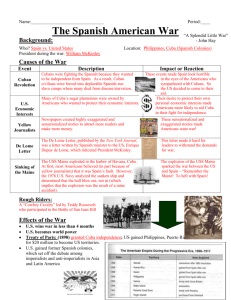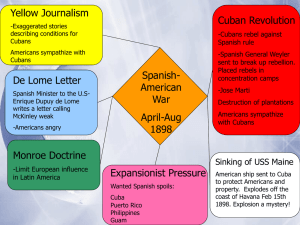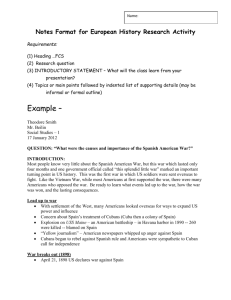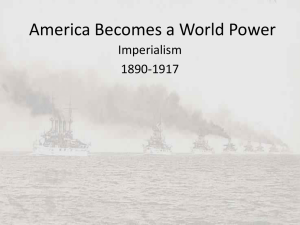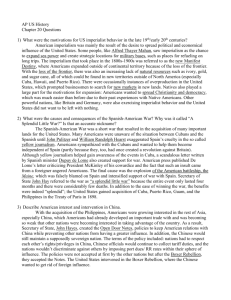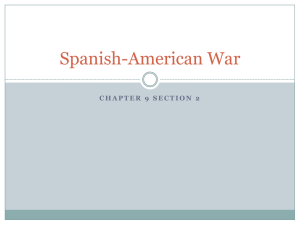Spanish-American-War PPT
advertisement
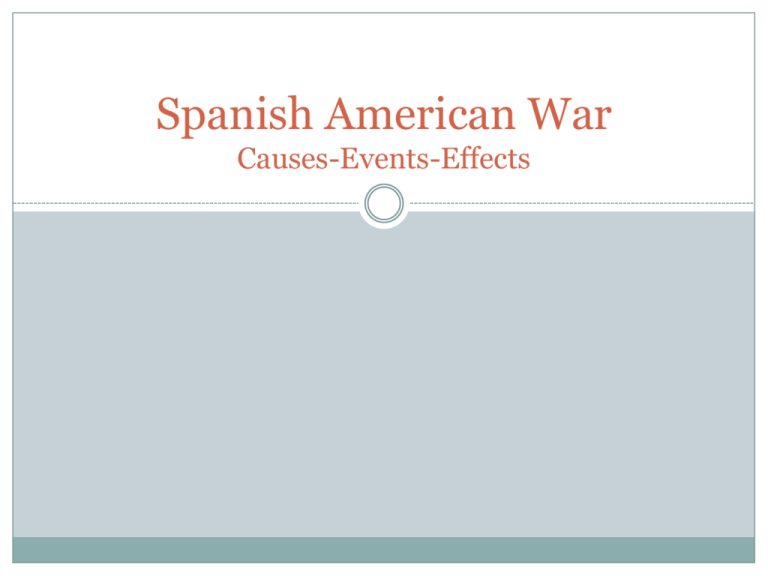
Spanish American War Causes-Events-Effects “A Splendid Little War”secretary of state John Hay • This was an immensely popular war with the American people • For the first time since the Civil War men from the north and south fought side by side for a common cause • It lasted less than 100 days, resulted in over 4,000 deaths (only 289 battle deaths) - most from disease (particularly yellow fever) and food poisoning), and resulted in a resounding victory over the once great Spanish Empire • It changed the course of American history, making the US a full fledged world power with new responsibilities in the Pacific and Caribbean Important Causes 1. 2. 3. 4. 5. US Business Interests in Cuba American Sympathies for Cubans De Lome Letter Sinking of the USS Maine Yellow Journalism 1. US Business Interests in Cuba Repressive Spanish rule caused Cubans to revolt in 1895 – demanding their independence Fighting between Cuban nationalists (rebels) and the Spanish military threatened US investments and property in Cuba Most businessmen wanted the US to help Spain at first Sugar mills and plantations were attacked by Cuban nationalists led by Jose Marti in hopes of forcing the US to help the Cuban rebels $100’s of millions of lucrative trade and investments between US and Cuba was threatened by a long drawn out war 2. American Sympathies for Cubans • Many Americans sympathized with the Cuban Rebellion because . . . – – – – – – Americans had themselves fought for Independence from colonial rule during the American Revolution The cry “Cuba Libre!” reminded Americans of Patrick Henry’s “Give me Liberty or Give me Death” Cuba was only 90 miles from Florida, and much of the funding and organization for the revolution came from Cuban immigrants in the US (NY & FL) Most Cubans were Catholic, as were many Americans Thousands of Americans lived and worked in Cuba As 1898 events were sensationalized in the yellow press (newspapers) more and more Americans favored war against Spain 3. De Lome Letter • February 1898 the New York Journal published a private letter written by the Spanish Ambassador to Washington, DC – – – In the letter Enrique Dupey de Lome criticized president McKinley, claiming he was “weak and a bidder for the admiration of the crowd” Americans were outraged and considered his comments an insult against the US Although de Lome resigned as Ambassador it was too late the damage had been done and many more Americans now called for war against Spain 4. Sinking of the USS Maine • The USS Maine (battleship) was sent to Havana Harbor, Cuba days after the de Lome letter was made public for TWO REASONS: – – To protect American citizens and if necessary evacuate them if a threat to their safety arose Press Spain to settle the conflict with the Cuban nationalists • Feb 15, 1898 the USS Maine exploded killing over 260 men • Immediately American newspapers (yellow press) owned by publishers William R. Hearst and Joseph Pulitzer printed stories blaming the explosion on a Spanish mine. • Even Assistant Secretary of the Navy, future president Theodore Roosevelt, said that “the Maine was sunk by an act of dirty treachery on the part of the Spanish” • Most historians now believe the real cause of the explosion was an onboard fire in the coal bunkers that then spread to an adjacent room that contained explosives • Immediately the cry “Remember the Maine, to hell with Spain!” rang throughout the US as jingoism increased immediately 5. Yellow Journalism • Throughout the Cuban revolution American newspapers sensationalized, even fabricated, stories about the mistreatment of Cuban’s by the Spanish in order to sell more newspapers • This type of sensationalized newspaper coverage was known as “Yellow Journalism” • William R. Hearst (publisher) reportedly said to his most gifted artist “You furnish the pictures and I’ll furnish the war” • Stories (most false or exaggerated) about the mistreatment of Cuban’s by the Spanish General Valeriano “the Butcher” Weyler stirred sympathy and outrage in America – – – – His use of concentration camps where thousands died from malnutrition, mistreatment and disease Stories of his soldiers poisoning wells Stories of his soldiers throwing children to the sharks Stories of Spanish officials strip searching women War is Declared • Despite the fact that Spain agreed to almost everything • • • • the US demanded, an intense burst of nationalism fueled war fever (Jingoism) lead to a call for war President McKinley could no longer ignore or control On April 20, 1898 the US declared war on Spain The US Army was ill prepared for war – numbering only 28,000 men (most of these men were in the west) to Spain's 100,000+ The US Navy on the other hand was more modern than Spain's The first fighting occurred not in Cuba, but in another Spanish colony thousands of miles away . . . the Philippines War in the Philippines Before the US began to fight in Cuba, war began in another Spanish colony, the Philippine Islands On orders from Sec. of Navy Teddy Roosevelt, Commodore George Dewey moved 6 US ships from Hong Kong in order to prepare to invade the Philippines On May 1st Dewey and his fleet attacked the Spanish squadron In 7 hours the US demolished the Spanish forces The Storming of Manila Dewey wanted for reinforcements and with the help of Filipino patriot Emilio Aguinaldo captured Manila on August 13, 1898 Aguinaldo joined the US with the belief that the US would grant the Philippines their independence after Spain was defeated He was mistaken US Troops Land in Cuba Under the command of General Nelson Miles and General William Shafter, 17,000 troops landed in Santiago The US troops, which included African Americans, who were anxious to bring independence to Cubans, many of whom were of African descent or mulattos Fighting began on the island on June 20, 1898 The Rough Riders One unit became known as the “Rough Riders” The were a colorful regiment of volunteers under the supervision of Teddy Roosevelt They were undisciplined and not always effective fighters, but embodied the American enthusiasm for the fight against Spain On June 22 the charged up San Juan Hill, a strategically important part of the ridges surrounding Santiago African Americans in the War The role of African Americans was largely ignored by the press There were numerous African Americans outfits that were racially segregated in the US Army and they played a central role in defeating the Spanish Battle of Guasimas The black 9th and 10th Cavalries (the “Buffalo Soldiers”) opened the way for the Rough Riders, possibly saving them from annihilation Defeating the Spanish The battle of San Juan Hill, the first major land battle of the Spanish American War, turned out to be the last On July 3, the Spanish fleet tried to run from the US blockade, but were defeated in a one sided battle Puerto Rico After defeating the Spanish fleet, the US turned to Puerto Rico, which they conquered in July The War’s Toll on US Soldiers US ambassador to London, John Hay, called the Spanish American War, a “splendid little war” However, 385 soldiers were killed in action and another 5,000 died of tropical mosquito born disease Upon return the soldiers had to be quarantined in New York, so yellow fever would not spread in the US The Treatment of African Americans Even though the fought valiantly, the 9th and 10th cavalries never received the acclaim that the Rough Riders did. As troops passed through the South they were called racial slurs and refused service in restaurants and other public places Tensions were so high over their service that there were race riots in 1898 The “Splendid Little War” Spain signed a peace protocol or cease-fire on August 12, 1898. A day before Dewey and his troops captured Manila A permanent settlement was made in October 1898 Treaty of Paris In the Treaty of Paris, Spain granted independence to Cuba and ceded (gave) the US Puerto Rico, Guam, and the Philippines for a payment of $20 million The new territories added 100,000 square miles and close to 10 million people to the American empire The US Emerges as a World Power The US emerged as a world power, with an empire that stretched from the Caribbean Sea to the South China Sea. The economic and political consequences of such expansion created a new international role for the US.
